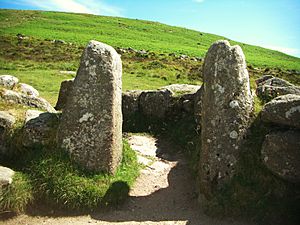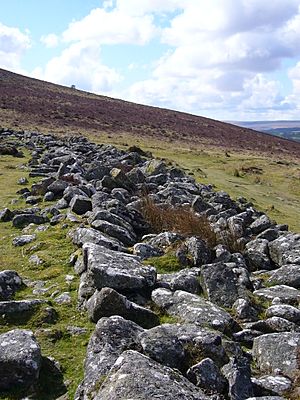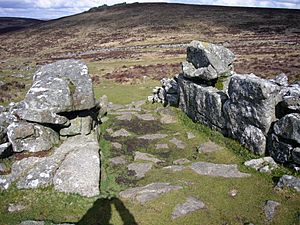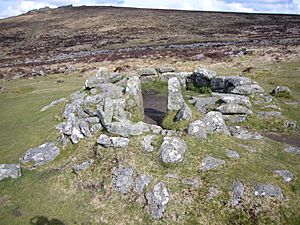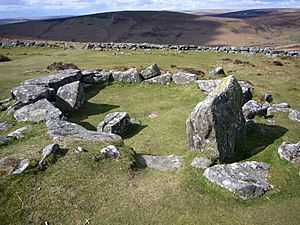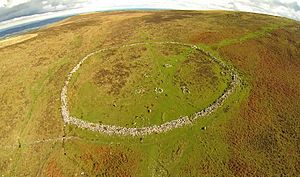Grimspound facts for kids

View of Grimspound from Hookney Tor
|
|
| Location | Dartmoor |
|---|---|
| Region | England |
| Coordinates | 50°36′48″N 3°50′13″W / 50.6133°N 3.837°W |
| Type | Settlement |
| History | |
| Periods | Bronze Age |
| Site notes | |
| Ownership | English Heritage |
| Public access | Yes |
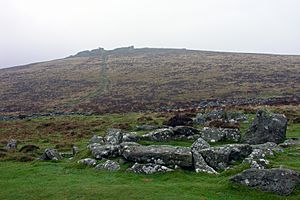
Grimspound is a very old settlement found on Dartmoor in Devon, England. It was built during the late Bronze Age, which was about 3,300 years ago. Imagine living in a place with 24 round houses, all surrounded by a low stone wall!
The name Grimspound was first written down in 1797. It might come from an old Anglo-Saxon god of war named Grim, also known as Woden or Odin.
In 1893, a team of archaeologists dug up parts of Grimspound. They learned a lot about how people lived there. They even rebuilt some parts of the site to show what it might have looked like.
Contents
Grimspound's History
People first started living at Grimspound around 1300 BC. The 24 round houses, called hut circles, were built inside a huge stone wall. This wall was made of granite and might have been as tall as 1.7 meters (about 5.5 feet) in some places.
The roundhouses were about 3.4 meters (11 feet) wide. They were built using two rings of granite slabs with smaller stones packed in between. This building method is still used today for dry-stone walls. One house, Hut 3, still has its doorway standing.
Archaeologists found signs that people lived here. They discovered pieces of pottery, tools for scraping, and "pot boilers." Pot boilers were stones heated in a fire and then dropped into water to make it boil for cooking. Sadly, things like wood or cloth didn't survive because the soil is very acidic.
What People Thought Grimspound Was
When Grimspound was first discovered, people had many ideas about what it was. Some thought it was a place where judges met, or even a special temple for ancient priests called Druids.
Other ideas included it being an Iron Age fort, a camp for tin miners, or even a settlement built by people from Phoenicia. Over time, archaeologists learned more about its true purpose.
Digging Up the Past
In 1893, the Dartmoor Exploration Committee started digging at Grimspound. One famous person on the team was Reverend Sabine Baring-Gould. During their dig, they rebuilt some parts of the site. This rebuilding helped people imagine what Grimspound looked like.
Where is Grimspound?
Grimspound is located in a valley between two hills, Hameldown Tor and Hookney Tor. It sits about 450 meters (1,476 feet) above sea level. The closest village is Widecombe-in-the-Moor, which is a few miles to the south.
What Grimspound Looks Like
The entire settlement is surrounded by a strong stone wall. There's a big, paved entrance that faces south, going uphill towards Hameldown. The wall was very thick, more than 4.5 meters (15 feet) in some spots!
Even though the wall was big, it wasn't really for defense. Experts think it was mostly to keep farm animals inside and wild animals out. It might have even had a hedge or fence on top. The main water source for the settlement was the West Webburn, which starts at the northern edge of the site.
The entrance is quite impressive. It's a paved path about 5.5 meters (18 feet) long and almost 2 meters (6.5 feet) wide. Huge stones, called megaliths, form its sides. It seems this entrance was not built to stop animals from coming in.
Archaeologists believe that walls like this were built by small groups of people working on different parts at the same time. You can sometimes see different building styles in the wall, which might show this.
The Hut Circles
There are 24 stone hut circles officially found at Grimspound. However, there might be more hidden inside the enclosure, which covers a large area of over 16,000 square meters (about 4 acres). Many of these huts have L-shaped porches at their entrances.
The doorways of the huts were paved with flat stones. All the doorways faced downhill and away from the strong winds.
The 1894 excavation found that the huts closest to the main entrance (except for Hut 12) didn't have many signs of people living in them. This suggests they might have been used for keeping animals or for storage. Hut 2, on the other side of the settlement, might have been used for this too.
The huts were between 2.7 and 4.5 meters (9 to 15 feet) wide. Their walls were about 1 meter (3 feet) thick. They were made of upright granite slabs filled with rubble and possibly peat. Other digs have shown that these huts likely had wooden planks lining the inside.
The cooking fires, called hearths, were sometimes in the middle of the hut or across from the door. Ash from the fires showed that people burned oak and willow twigs. There weren't many remains of logs, but there was peat ash. This tells us that by the time Grimspound was lived in, the local forests had been replaced by enough peat for people to use it as fuel.
Cooking holes contained granite "pot boilers." These were pieces of stone heated in the fire and then dropped into pots of water that were sunk into the ground. This was how they boiled water, as their pottery couldn't go directly on the fire.
To the right of each hut entrance, there was a raised, flat area. This was probably where people slept. Four of the huts (3, 7, 17, and 18) have special raised stones, called "anvil" stones, but no one knows exactly what they were used for.
Unlike many similar ancient sites, there isn't one hut that stands out as being much bigger, which might have belonged to a headman or leader.
Other Discoveries
The acidic soil of Dartmoor has destroyed almost all organic materials, like wood or cloth. This makes it hard to know exactly what Grimspound was like when people lived there.
Archaeologists found a flint arrowhead nearby. Also, they didn't find any querns, which are tools for grinding cereals. This suggests that the people of Grimspound might have gotten some of their goods from outside the area. For example, flint isn't found naturally on Dartmoor. The clay used for the pottery fragments also didn't come from the local area.



